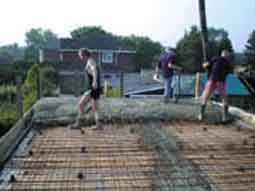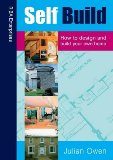This is the first in a regular series about self-build.

Self builders need a lot of help
In a small town in Eastern England the Harrall family have recently moved into their self-built house. The 4-bed structure is packed into the earth, has a planted roof, vegetable garden and energy consumption a quarter of an ordinary house of the same size.
Jerry Harrall describes his single-storey, Teletubby-esque home as “earth-sheltered”. “This building is a response to global climate change,” he says. “Our whole lifestyle is a response to that.”
Unobtrusive to the point of invisibility from the road, there’s a big hedge, a gravel area, then the two buildings, which are the performance part of Harrall’s PhD at the University of Lincoln – his aim being to prove the long-term value of passive solar design, where buildings absorb and retain heat. Harrall’s buildings have no foundations – just concrete blocks placed on the floor, rooted by gravity. His home’s earth roof is covered by a woven membrane to keep it in place, and I notice that the periwinkles planted to cover it are slightly sparse, having succumbed to a disease. We enter via raised wooden walkways. For rest of story click “more” below.
 The Self-Build Book: How to Enjoy Designing and Building Your Own Home – buy it from Amazon US
The Self-Build Book: How to Enjoy Designing and Building Your Own Home – buy it from Amazon US Self Build: Design and Build Your Own Home – buy it from Amazon UK
Self Build: Design and Build Your Own Home – buy it from Amazon UK
Harrall is a competitive cyclist and has built a gym in his garden. It is served, like the rest of his house, by solar-generated electricity. When he left school at 16, he became a plasterer, before retraining as an architect. “I’m on a journey of discovery,” he says. “I’ve decided to make a difference in my life.” He and his wife, Kay Woods, who have been together since they were 15, had to live with their children in a caravan on site during the build. It took almost four years. “It was tough,” says Woods, stoically, “particularly when the weather was bad. Anyone who’s done a self-build has been through it.” Mind you, most self-builders are not architects, especially not running the eco-architecture firm SEArch (Sustainable Ecological Architecture).
The house is reminiscent of the grass-topped bothies in Nordic climates. “Among my favourite buildings are those at Skara Brae in the Orkneys, the oldest known dwellings in the British Isles,” says Harrall. “They’re built into crags, face south, and had sod roofs. What we’re doing is not that new.”
The bricks in the walls make use of reclaimed materials: a mix of concrete and pulverised fuel ash and woodchip. A solar panel on the roof heats the water, but the family does take electricity from the grid – on a green tariff. Harrall is planning to install a wind turbine later this year to take them to full self-sufficiency. The kitchen walls are clad with aluminium, which looks dramatic – but Harrall isn’t entirely happy. “It’s the only metal that is truly recyclable, but I wouldn’t use it again as it marks.” Also mildly industrial is the larder, with its door of clear rubber blinds.
“We only have task lighting.” The house has no skirting boards, lintels, drainpipes or radiators. The walls are painted rather than rendered, for which there is a good thermodynamic reason. “We expose the bricks to achieve a high thermal mass,” Harrall explains. “In other words, the structure acts as a storage radiator, helping avoid extreme variations in internal temperature.”
The house is filled with wooden furniture by local maker Deryk Gilham. He shares Harrall’s passion for recycling and sourcing local materials, including bog oak – wood that fell into fenland swamps several thousand years ago and has an extraordinary, infinite black colour.
The house is clearly Harrall’s passion. So how does his wife feel about it? “I’m spoiled for light and space, which is uplifting,” she says. “We consider living here normal now. But I still notice when going to other houses how noisy they are. People often tell me how quiet it is here.”
Though light floods into the wide facade of the house, what about the back, which is buried under a bank of earth? Here, Harrall has placed the 10m corridor which connects the four bedrooms and bathroom. This corridor receives secondary light , filtering into the bedrooms from the garden through shot-blasted glass doors.
SEArch, 01406 364646.